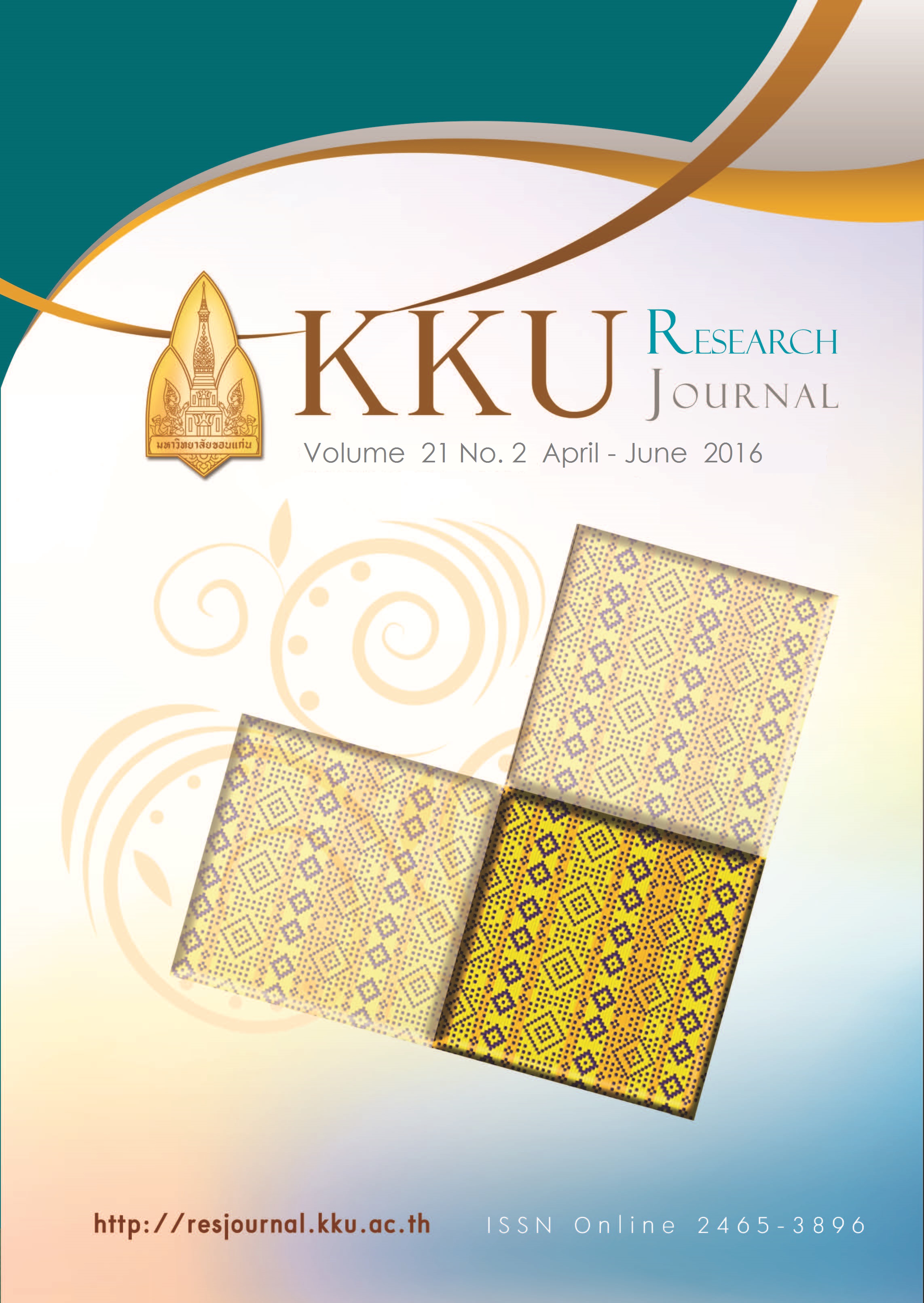Optimization conditions, antibacterial and antioxidant activities of clitopilus chalybescens
Main Article Content
Abstract
The aim of this work was to study the effect of media, temperature and pH on the mycelial growth of Clitopilus chalybescens strain MFLUCC 13–0809 collected from Lampang, Thailand. The antioxidant and antibacterial activities from the crude mycelial extracts were evaluated. The study indicated that the optimal medium, pH and temperature were observed on yeast extract agar (YEA) pH 5 to 7, and 20–29˚C, respectively. For antibacterial activities, crude extracts from mycelium slightly inhibited the growth of Gram positive bacteria (Bacillus subtilis, Staphylococcus aureus and Micrococcus luteus), but no activities were observed on Gram negative bacteria (Pseudomonas aeruginosa and Escherichia coli). Antioxidant assay indicated that the crude extract had noticeable scavenging activity on 2,2-diphenyl-1 picrylhydrazyle (DPPH) radical. The results suggest that the crude extract from this mushroom mycelium deem to have a potential for further development on antibacterial and antioxidant applications.
Article Details
References
[2] Singer R. The Agaricales in Modern Taxonomy. 4th Ed., Koeltz Scientific, Koenigstein; 1986.
[3] Noordelood ME. Funga Nordica. Nordsvamp, Copenhagen; 2008.
[4] Vyas D, Chaubey A, Dehariya P. Biodiversity of mushrooms in Patharia forest of Sagar (M.P.)-III. Int J Biodivers Conserv. 2014;6(8):600-607.doi:10.5897/ IJBC2014.0681.
[5] Bi ZS, Li TH, Zhang WM, Song B. A preliminary agaric flora of Hainan Province. Guangdong, China press; 1997.
[6] Yang ZL. Clitopilus amygdaliformis, a new species from tropical China. Mycotaxon. 2007;100:241-246.
[7] Vizzini A, Musumeci E, Ercole E, Contu M. Clitopilus chrischonensis sp. nov. (Agaricales, Entolomataceae), a striking new fungal species from Switzerland. Nova Hedwigia. 2011;92:425-434. doi:10.1127/ 0029-5035/2011/0092-0425.
[8] Qiu DW, Hui LT, Heng SY. A new variety of crepidotoid Clitopilus from Taiwan, China. Mycosystema. 2010;29(6):924-926.
[9] Baroni TJ, Desjardin DE, Hywel-Jones N. Clitopilus chalybescens, a new species from Thailand. Fungal Divers. 2001; 6:13-17.
[10] Deng WQ, Li TH, Shen YH. A new species of Clitopilus from southwestern China. Mycotaxon. 2012;122:443-447.
[11] Brand-Williams W, Cuvelier ME, Berset C. Use of free radical method to evaluate antioxidant activity. LWT. Food Sci Technol. 1995;28(1):25-30.
[12] Irene A. Papa IA, Zulaybar TO, Raymundo AK. Increasing Pleuromutilin Activity of Clitopilus passeckerianus By Chemical Mutagenesis and Improvement of Production Medium. 2006;89(1): 20-33.
[13] Vicente MA, Raymundo AK, Quimio TH. Optimization of growth conditions of the wild-type and mutant Strains of the Pleuromutilin-producing Clitopilus passeckerianus (PILAT) SING. NRRL 3100. NRCP Res J. 2006.8/9:20-27.
[14] Zervakis G, Philippoussis A, Ioannidou S, Diamantopoulou, P. Mycelium Growth Kinetics and Optimal Temperature Conditions for the Cultivation of Edible Mushroom Species on Lignocellulosic Substrates. Folia Microbiol. 2001;46(3):231-234.
[15] Marek Siwulski M, Sobieralski K, Górski R, Lisiecka J, Sas-Golak I. Temperature and pH impact on the Mycelium growth of Mycogone perniciosa and Verticillium funggicola isolates derived from polish and foreign mushroom
growing houses. J Plant Prot Res. 2011;51(3):268-272.
[16] Chang ST, Miles PG. Mushrooms: cultivation, nutritional value, medicinal effect, and environmental impact. 2nd ed., CRC Press, Boca Raton; 2004.
[17] Rosa LH, Machado KMG, Jacob CC, Capelari M, Rosa CA, Zani CL. Screening of Brazilian Basidiomycetes for antimicrobial activity. Mem Inst Oswaldo Cruz. 2003;98:967-974.
[18] Akyuz M, Kirbag S. Antimicrobial activity of Pleurotus eryngii var. ferulae grown on various agro-wastes. Eurasia J Biosci. 2009;3:58-63.doi:10.5053/ejobios.2009.3.0.8.
[19] Kavanagh F, Hervey A, and Robbins WJ. Antibiotic substances from basidiomycetes: IX.
Drosophila subatrata (Batsch Ex Fr.) quel. Proc Natl Acad Sci USA. 1952;38(7):555-560.
[20] Hartley AJ, de Mattos-Shipley K, Collins CM, Kilaru S, Foster GD, Bailey AM. Investigating pleuromutilin producing
basidiomycetes and related Clitopilus species. FEMS Microbiol Lett. 2009;297:24-30. doi:10.1111/j.15746968.2009.01656.x.
[21] Kavanagh F, Hervey A, Robbins WJ. Antibiotic substances from basidiomycetes. VIII. Pleurotus multilus (Fr.) Sacc. and Pleurotus passeckerianus Pilat Proc Natl Acad Sci USA. 1951; 37(9):570-574.
[22] Yamac M, Bilgili F. Antimicrobial activities of fruit bodies and/or mycelial cultures of some mushroom isolates. Pharmaceutic Biol. 2006; 44: 660–667.


